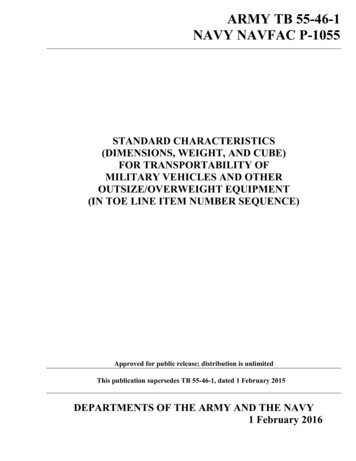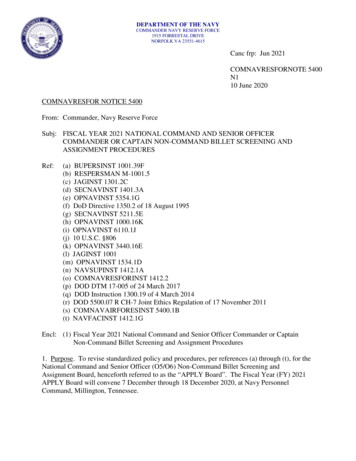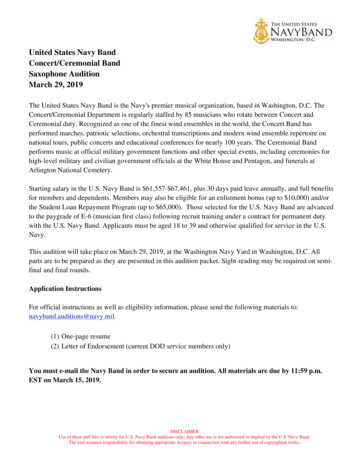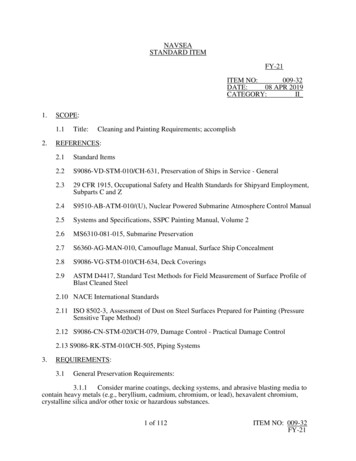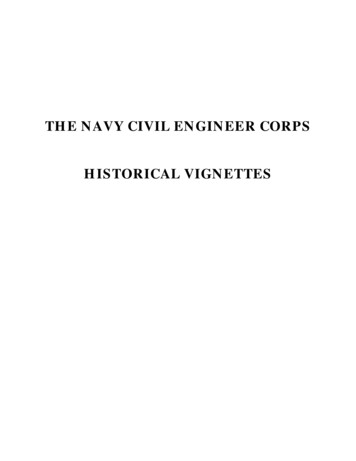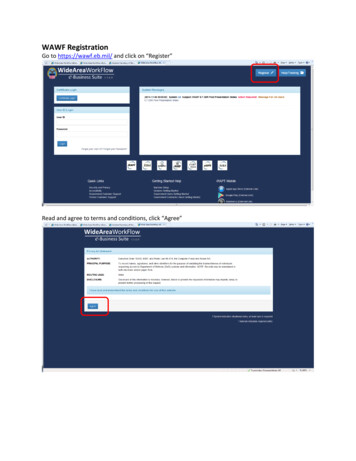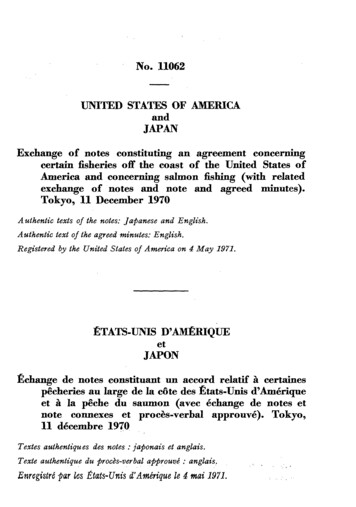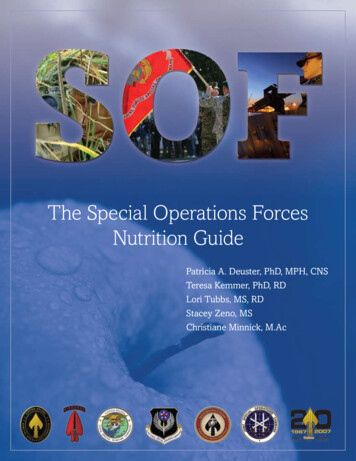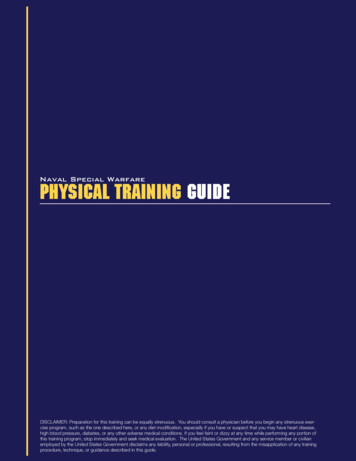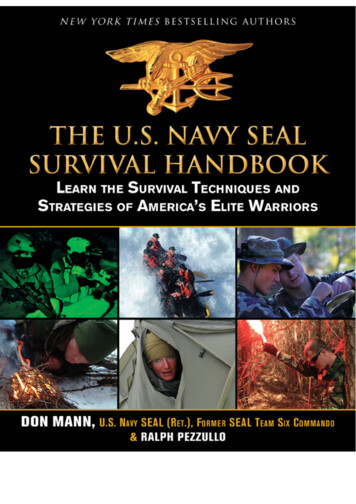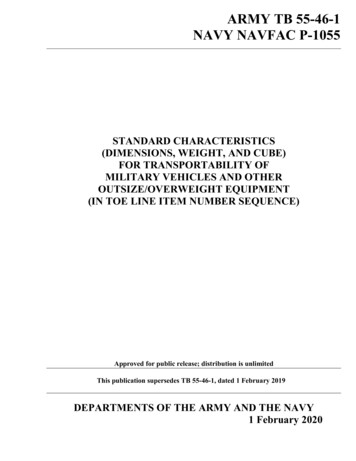
Transcription
ARMY TB 55-46-1NAVY NAVFAC P-1055STANDARD CHARACTERISTICS(DIMENSIONS, WEIGHT, AND CUBE)FOR TRANSPORTABILITY OFMILITARY VEHICLES AND OTHEROUTSIZE/OVERWEIGHT EQUIPMENT(IN TOE LINE ITEM NUMBER SEQUENCE)Approved for public release; distribution is unlimitedThis publication supersedes TB 55-46-1, dated 1 February 2019DEPARTMENTS OF THE ARMY AND THE NAVY1 February 2020
*TB 55–46–1NAVFAC P–1055TECHNICAL BULLETINNo. 55–46–1NAVY PUBLICATIONNo. P–1055}HEADQUARTERSDEPARTMENTS OF THE ARMYAND NAVYWASHINGTON, DC, 1 February 2020STANDARD CHARACTERISTICS(DIMENSIONS, WEIGHT, AND CUBE)FOR TRANSPORTABILITY OF MILITARYVEHICLES AND OTHER OUTSIZE/OVERWEIGHT EQUIPMENT(IN TOE LINE ITEM NUMBER SEQUENCE)Approved for public release; distribution is pose and Scope .Definitions .Data Specifications .Unit Movement Data (UMD) Reporting Procedures .Reporting of Publication Improvements 32.TABLESEquipment Transportability Criteria .Cargo Compartment Dimensions and Loading Capacity .Wheelbase Dimensions .Metric Conversion Table NT CHARACTERISTICS DATAExplanation of Columnar Headings .Equipment Characteristics Data Listings.3–13–23–13–5A.B.C.REFERENCES .CROSS-REFERENCE NATIONAL STOCK NUMBER TO TOE LIN .CROSS-REFERENCE ARMY MODEL AND NAVY CIVIL ENGINEER SUPPORTEQUIPMENT (CESE) DESIGNATION TO TOE LIN AND CARGO GROUP CODE .LIST OF TRANSPORTABILITY GUIDANCE TECHNICAL MANUALS(TM) AND TECHNICAL BULLETINS (TB) his bulletin supersedes TB 55–46–1, 1 February 2019.i
TB 55–46–1/NAVFAC P–1055LIST OF �253–1C–1C–2D–1D–2iiTitleEquipment Transportability Criteria for AMC Aircraft .463L Pallet Criteria for CRAF Aircraft .Aircraft Allowable Cabin Loads (ACL) .Cargo Category Codes .Heavy Lift and Dimension Codes .Dimensions and Loading Capacity for Cargo Truck Bodies .Dimensions and Loading Capacity for Dump Truck Bodies.Dimensions and Loading Capacity for Cargo Trailer Bodies.Dimensions and Loading Capacity for Stake Semitrailer Cargo Bodies .Dimensions and Loading Capacity for Van Semitrailer Cargo Bodies .Dimensions and Loading Capacity for Amphibious Vehicles.Dimensions and Loading Capacity for Landing Craft.Dimensions and Loading Capacity for FTRAC Cargo Carrier Bodies .Dimensions and Loading Capacity for Army Helicopter Cargo Compartments .Wheelbase Dimensions for Trucks .Wheelbase Dimensions for Trailers .Wheelbase Dimensions for Semitrailers .Wheelbase Dimensions for Truck-Lift Forks .Wheelbase Dimensions for Truck-Mounted Equipment .Wheelbase Dimensions for Trailer-Mounted Equipment .Wheelbase Dimensions for Semitrailer-Mounted Equipment .Wheelbase Dimensions for Truck/Trailer-Mounted Power Units .Wheelbase Dimensions for Wheeled Tractors .Wheelbase Dimensions for Wheeled Engineer Equipment .Metric Conversion Table .Types of Equipment Codes and Their Meanings .Cargo Group Code Examples/Explanations .Cargo Group Code Criteria .DA Technical Manuals (TMs) .DA Technical Bulletins (TBs) ��1C–3C–3D–3D–3
TB 55–46–1/NAVFAC P–1055CHAPTER 1INTRODUCTION1–1. Purpose and scopea. This technical bulletin (TB) provides dimensions,weight, and cube of military vehicles, vehiclemounted equipment, and other outsize/overweightequipment. Staff, command, and field organizationsuse this data for standard reference in developing andreporting movement requirements. The data isspecif-ically oriented to unit movementtransportability/deployability considerations and isdesigned for com-patibility with the U.S. ForcesCommand (FOR-SCOM) Computerized MovementPlanning and Status System (COMPASS); JointOperations Planning and Execution System (JOPES);DOD Regulation 4500.9–R; and AR 71–32.b. This publication consists of all outsized/overweight equipment having dimensions and weightequal to or exceeding 104 inches long, 84 incheswide, 50 inches high, and 5,000 pounds. These criteria define the minimum reporting standards necessaryto provide a basis for identifying cargo with potentialtransportability limitations. Data for all equipment,including those that are less than the above criteria,are listed in the TEA web application, Standard Characteristics (Dimensions, Weight, and Cube) forTransportability of Military Vehicles and w.tea.army.mil/pubs.c. The data in this publication applies primarily toequipment included in Army table of organizationand equipment (TOE) or modified tables of organization and equipment (MTOE) plus Navy tables of allowance (TOA) for the Naval Construction Force(NCF). Data for other end-items listed in Supply Bulletin (SB) 700-20 are included when available. Everyeffort is made to maintain current TOE line itemnumber (LIN) assignments according to SB 700-20and national stock number (NSN) assignments according to the Army Master Data File (AMDF).d. The Surface Deployment and Distribution CommandTransportationEngineeringAgency(SDDCTEA) is the U.S. Army central point of contact for obtaining vehicle/equipment air transport certification from Headquarters Air Force MaterialCommand (HQ AFMC), Aeronautical Systems Cen-ter (ASC). U.S. Army units requiring airlift certification should, per DOD 5000.2, forward their requeststo Director, SDDCTEA, ATTN: SDTE-DPE, Building 1900W, 1 Soldier Way, Scott AFB, IL 62225,with an information copy to Commander, FORSCOM, ATTN: AFOP-OCP-FS, G3/5/7 MCSCOMPASS, 4700 Knox Street Fort Bragg, NC28310. The U.S. Navy central point of contact for obtaining airlift certification for Civil Engineer SupportEquipment (CESE) is Commanding Officer, Naval Facilities Expeditionary Logistics Center, Code N442,CESE Management Branch, Building 1000, 23d Avenue, Port Hueneme, CA 93043.1–2. Definitionsa. Cargo Group Code. This code is applied to vehicles and vehicle-mounted equipment for use withthe Air Mobility Command (AMC) type unit loadprogram. Appendix C lists the cargo group code criteria and assignment of vehicles to Army model designation, shipping configuration, and TOE LIN to include dimensions (length, width, height) and weight.b. Civil Engineer Support Equipment (CESE)(Navy). CESE is a procurement budget term referringto equipment for which COMNAVFACENGCOMhas the responsibility for determining requirements,procuring, and assigning. The equipment includesautomotive vehicles (including tactical), construction, railway, firefighting, and mobile weight handling equipment. Weight handling equipment such asportal, gantry, jib, and other facility cranes are normally not classified as CESE.c. Disassembled Component. A component removed from an end-item, reducing the item’s shipping configuration.d. Line Item Number (LIN).(1) Army. A six-character alphanumeric identification assigned to a generic nomenclature to describecollectively all NSN items possessing the functionalcapability expressed by the LIN description. It isused as the basic reference in Army equipment authorization documents, such as, TOE, MTOE, common table of allowances (CTA), and table of distribution and allowances (TDA).1–1
TB 55–46–1/NAVFAC P–1055(2) Navy. Navy equipment is identified by a sixdigit equipment code (EC). Each EC describes a generic category of equipment.(3) Specific Combinations of Equipment for theIntegrated Computerized Deployment System/AirLoad Module (ICODES/ALM). Union LINs are nolonger accepted through COMPASS.(4) Fictitious LINs. Fictitious LINs are assignedto authorized NSN items of equipment that do nothave an assigned LIN. The use of a fictitious LINenables entry of that item into this bulletin. Thesefictitious LINs, denoted with the prefix “YA”, areprohibited for use in authorization documents.e. National Stock Number (NSN). The NSN consists of a 13-digit number assigned by Defense Logistics Services Center. The first four digits of the NSNare known as a Federal Supply Classification (FSC)code and the last nine digits are referred to as the National Item Identification Number (NIIN). The NIINfixes the identity of the particular item of supply.f. Naval Construction Force (NCF) (Navy). The generic term applies to that group of deployable navalorganizational components, primarily, Naval MobileConstruction Battalions (NMCB), that have the common characteristics of processing the capability toperform construction projects for the Navy. The NCFis composed of both active and reserve units. Oncemobilized there is no distinction made between activeand reserve units. The NCF provides the followingcapabilities in support of the U.S. Navy, as well asother agencies of the U.S. Government, when directed:(1) Responsive military advanced base construction support including operational, logistics, underwater, ship-to-shore, shore, and deep ocean facilitiesconstruction, maintenance, and operation.(2) Military construction in support of Marine AirGround Task Force (MAGTF) operations.(3) Defensive and limited offensive operationsagainst overt or clandestine enemy attacks directedtoward unit personnel, convoys, camps, and facilitiesunder construction.(4) Amphibious assault and ship-to-shore construction support operations.(5) Battle damage repair operations.(6) Disaster control and recovery operations.(7) Civic action employment.g. Table of Allowance (TOA) (Navy). The organization listing of personnel, materiel, and equipment developed to enable naval components to meet theirgeneral mission requirements.1–2h. Vehicle. The term “vehicle” includes trucks,trailers, semitrailers, amphibious and tracked vehicles, tanks, artillery (self-propelled and towed), floating craft (self-propelled and towed), railcars, locomotives, aircraft (including helicopters), and wheel ortrack-mounted equipment.1–3. Data specificationsa. Source of Data. The data in this bulletin was obtained by or under the technical supervision ofSDDCTEA.b. Accuracy of Data. The accuracy of data is identified by the letter “V” located to the extreme left ofan INDEX NUMBER (INDEX NO) in the equipmentcharacteristics data listing (para 3–2). The “V” indicates that the data are actual validated measurementsand weight acquired according to technical standardsestablished by SDDCTEA. Absence of a “V” for anylisting indicates that the information shown is the bestavailable and is obtained from research of technicalpublications.c. Dimensions.(1) Length. The horizontal dimension measuredfrom end-to-end and parallel to the central axis.Measurement is rounded up to the nearest inch.(2) Width. The horizontal dimension measuredfrom side-to-side and perpendicular to the central axis.Measurement is rounded up to the nearest inch.(3) Height. The vertical dimension measuredfrom ground level to highest reference point. Measurement is rounded up to the nearest inch.d. Weight. The amount an item weighs expressed inpounds.(1) Aircraft. The weight of an aircraft in operational/flyaway configuration includes installedequipment and full fuel load. The weight in eitherreduced or reduced for sealift configuration excludesfuel. These weights also do not include payload,crew, or personal/organizational equipment. Theyare not an integral part of the aircraft.(2) Surface Vehicles (less heavy armored vehicles/tanks). The weight of these vehicles includes onequipment materiel (OEM), such as basic issue items(BII) that are an integral part of the vehicle when issued, and fuel tank three-quarters full. It does not include payload, crew, or personal/organizationalequipment. They are not an integral part of the vehicle.(3) Heavy Armored Vehicles/Tanks. The weightis an average of several like items because like itemsdiffer in weight. It should be emphasized that varia-
TB 55–46–1/NAVFAC P–1055tions exist among the same models produced by different manufacturers and, in some cases, the samemanufacturer.(4) Other End-Items. The weight is based normally on the bare item configuration. In some instances, the weight is based on boxed, crated, or itemcontainer packaged configuration and is so noted.e. Cube. The volume of space occupied by the item,computed by multiplying the length by the width bythe height in inches, divided by 1,728 (formula: (L W H) / 1,728 cubic feet). The cube is rounded upto the nearest cubic foot.1–4. Unit movement data (UMD) reportingproceduresa. General. The equipment characteristics data listings contained in chapter 3 are designed to facilitatethe preparation of UMD reports. This data reflectsspecified shipping configurations and should be usedonly when the actual shipping configuration of anitem closely approaches the data listing or a major revision for UMD reporting has taken place.b. Use of LIN and INDEX NO. When properly reported, the combination of LIN and INDEX NO willcause computer generation of the data listed to theright of the INDEX NO for printing the UMD listing.An error in reporting either of these data elementswill result in computer application of erroneous data.Adherence to the following instructions will minimize reporting errors:(1) Do not report the INDEX NO assigned to an“assembled” shipping configuration. The assembledrecord contains no dimensional data, but has the totalweight and cube for all components when fully assembled. These data are for information purposesonly.(2) When reporting vehicle data ensure that theINDEX NO listing includes type of equipment codes0 through 9 or C through H, J, and K only. Similarly,the INDEX NO used to report non-vehicular or special-handling cargo data includes type of equipmentcodes L through N, P through V, X, and Y only.(3) Do not use the INDEX NO for a “remarks”listing.(4) If the equipment characteristics data are notavailable for the planned shipping configuration, theunit will request from FORSCOM the procedures onhow to report the equipment.c. Aircraft with Components. See data listing forLIN A29744 and K31042 as an example.(1) A29744. Airplane Cargo.(a) Vehicle Data. Report LIN A29744 and INDEX NO 02 (reduced configuration) plus other necessary information.(b) Disassembled Component Data. The component “wings” are classified as special-handling cargo.If component is loaded in an organic cargo vehicle, report as vehicle load, using the appropriate load description or, if not so loaded, report LIN A29744 and INDEXNO 03 (bare item). Note: The Wings are packed in twoboxes; therefore, two entries must be reported.(2) K31042. Helicopter Observation. Data is provided for the following shipping configurations: Flyaway, Reduced for Sealift, Reduced for C–130, Reduced for C–17, Reduced for C–5, and Reduced forSealift Operational. Movement plans should reflectthe most probable means of strategic transport. Forexample, if a unit expects to use the Reduced for C–130 shipping configuration, the data to be selectedand reported are as follows:(a) Vehicle Data. Report LIN K31042 and INDEX NO 04 (Reduced for C–130) plus other necessaryinformation.(b) Disassembled Component Data. Four of thecomponents—Main Rotor Blades, Vertical Fin, Horizontal Stabilizer, and Tail Boom—are classified as“special-handling cargo”. If items are loaded in an organic cargo vehicle, report the appropriate load description or, if not loaded, report LIN K31042 and INDEX NO 05 (for Main Rotor Blades); LIN K31042and INDEX NO 06 (for Vertical Fin); LIN K31042and INDEX NO 07 (for Horizontal Stabilizer); andLIN K31042 and INDEX NO 08 (for Tail Boom) separately. Note: Two entries must be reported for theMain Rotor Blades.d. Assembled Equipment. See data listing for LINT15644, “Shop Equip Mach Shop”, for assembledequipment.(1) Do not report INDEX NO 01 for assembledshipping configuration.(2) Report the disassembled components identified by INDEX NOs 02 through 06, depending onMODEL on hand, as follows:(a) Report those components that are loaded onorganic cargo vehicles.(b) If components are not loaded on vehicles, report as special-handling cargo, palletized, or containerized cargo, using appropriate LIN and INDEX NO foreach item.1–5. Reporting of publication improvementsa. You can help improve this manual, if you findany mistakes SDDCTEA requests recommendationsor changes for improvement to this publication be1–3
TB 55–46–1/NAVFAC P–1055prepared as a memorandum and forwarded to Director, SDDCTEA, ATTN: SDTE–SI, Building 1900W,1 Soldier Way, Scott AFB, IL 62225 or telefax (FAX)to the following Commercial FAX number 618-2205125. SDDCTEA will also accept comments ea-
Feb 01, 2020 · b. Civil Engineer Support Equipment (CESE) (Navy). CESE is a procurement budget term referring to equipment for which COMNAVFACENGCOM has the responsibility for determining requirements, procuring, and assigning. The equipment includes automotive vehicles (including tactical), construc-tion, railway, firefighting, and mobile weight han-dling .
